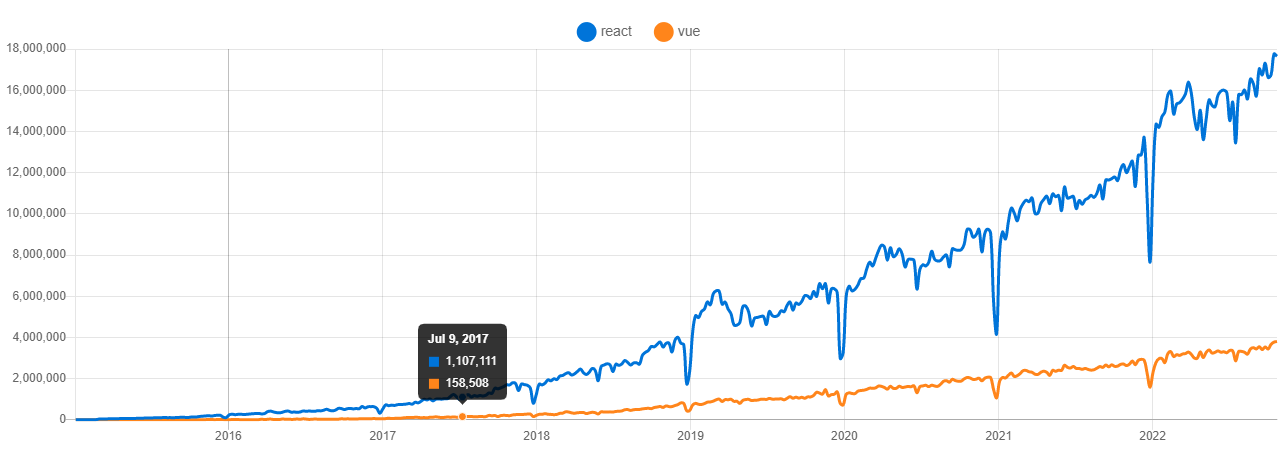
It is a valid reason that whether it is a startup or a well-established business, all would like to use a robust codebase for building their applications. Consequently, they don’t want to change or modify the apps. Hence, businesses are always looking for a scalable and flexible framework that offers them intrusive flexibility while fostering a more comfortable user experience.
Increasing usage of mobile apps in people’s daily lives and constant involvement in technology have given birth to many tools and frameworks. As a result, developers often face dilemmas regarding what library and framework to choose in order to build a highly scalable product. Indeed, there are many frameworks, but you will not come across any input framework that comes with a high amount of flexibility and robustness as you will get from JavaScript’s well-known framework, React.
Yes, React cannot be compared with any framework. Many practical front-end frameworks are available to ease the web development process, but most development companies widely use React. React is a JavaScript package that was initially created for Facebook that helps developers create single-page apps’ user interfaces by breaking up the user interface into modular components.
React has become more well-liked as a front-end web development technology because it just needs a basic familiarity with HTML and JavaScript. This blog aims to explain why you should use React and prefer to other frameworks and libraries, how it can aid in the front-end development process, and why you should use React when choosing a front-end development library for your next project in 2025.
What is the React Framework Exactly?
Usually, React developers describe it as “a javascript library for building user interfaces.” However, the majority of people refer to it as a framework and include it alongside Angular and Vue in the revered holy trinity of front-end javascript frameworks.
Jordan Walke developed React while working at Facebook in 2011. The platform had expanded so much by that point that the available solutions were insufficient, so they created their own front-end framework (or library) to accommodate their growing requirements. React was open-sourced in 2013, and since then, it has expanded rapidly, with new features being introduced regularly and an incredible developer community forming around it.
One of React’s key benefits, which we shall discuss in more detail later in the post, is the vibrant community. The Node package manager, the npm Registry, and the npm CLI were created by npm, Inc., which is represented by official data on the graph below. The graph displays download data for React, Vue, and Angular packages over the previous five years.
Source: npm Trends
Moreover, according to StackOverflow’s recent study, React is the second most popular development library that is liked and used by 68.9% of respondents. React has flourished in the developer community as a library for creating online UI components. Currently, the following well-known businesses and brands use React:
- Airbnb
- Dropbox
- PayPal
- Uber
- Netflix
After defining React.js, another important issue arises: Why is this library so well-liked? What advantages of React motivate so many companies to use it? Let’s discuss it in our next section.
Why Use React? Abd is That Good Choice for Web Development?
ReactJS is an open-source JavaScript library created by Facebook for quickly and easily building dynamic and engaging online applications. To offer the best rendering performance possible is ReactJS’ main goal. Its strength stems from the attention paid to each component separately. ReactJS enables a developer to divide the intricate user interface into simpler components rather than working on the complete web application.
Therefore, if you’re unsure about using React in your upcoming project, we can provide you with a whopping 8 justifications!
React Comes with High Flexibility
React is incredibly adaptable. Once you have mastered it, you can create high-quality user interfaces on various platforms. React is NOT a framework; it is a library. React’s library-based approach has enabled it to develop into such an amazing tool.
Your current apps can also use React. This is what React was created with in mind. React can be used to modify a tiny section of your current program, and if the modification is successful, you can begin converting your entire application to React.js. Facebook applied the same strategy.
React is Declarative
In contrast to the imperative style, where you instruct the machine on accomplishing a task, the declarative style lets you respond and decide what needs to be done. The declarative style is superior since you need not worry about implementation. Imagine that you are given the instruction to hang clothes in order to provide a better understanding. In imperative style, you will perform like this,
- Go to bathroom
- Put clothes in the bucket
- Take it outside and hang the same on the rope
In declarative style,
- I want my clothes to be hung on the rope.
Yes, this same approach React follows. Significant data changes are made possible via ReactJS, which causes selected user interface elements to change automatically. Due to its progressive functionality, you don’t need to undertake additional tasks to update your user interface.
Simplicity
ReactJS’s simplicity is arguably the main factor that convinces so many people to adopt and use react js in their projects. In addition, since React is a JavaScript library, developers who are already familiar with JS functions will find it easier to get started with ReactJS.
With the use of this library, programmers can define interfaces using JSX, an HTML-like syntax. Code for HTML and CSS is created as a result. The only preparation required before using React is to become familiar with a few fundamental functions.
Reusable Components
The framework’s component-based structure allows for the progression from tiny to large components. For instance, you can begin your coding with simple elements like a dropdown menu, checkbox, or button and then use these to create larger wrapper components. In React JS, each component has a distinct internal logic that indicates how the component is rendered. One of its main benefits is the ability to reuse components from this JavaScript library across all platforms.
Virtual DOM
ReactJS speeds up the webpages by utilizing its Virtual DOM to optimize this. As the name implies, virtual DOM is not the actual DOM but rather its virtual version. A vDOM is updated each time a webpage element is changed. A reconciliation mechanism from React is then used to compare the modified VDOM to a real DOM. This procedure is used to determine the smallest possible set of modifications to make to the actual DOM.
Ability to Develop Isomorphic Apps
Literally, the ability implies that you can utilize the same code base for both the client and server sides of an application.
React’s success in the realm of web design and development is explained by the qualities listed in this section. By deciding on React JS, you get a lot of advantages, such as fast apps and websites. You should nevertheless examine the library’s visibility and crawling across several browsers. Some browsers and search engines may not fully support all of its capabilities.
Growing All The Time
The development of React Native is ongoing. The enormous React Native community and Facebook are both actively trying to improve the framework. So if React Native doesn’t currently have a solution to your problem, things may change in a few months.
It was also noticed by Microsoft, which led to the development of React Native for Windows. Their approach makes it simpler for developers to produce Xbox One, Windows 10, and Windows 10 Mobile apps.
What is React Mainly Used For?
With over 94,000 sites using ReactJS and an estimated 1,300 developers, it has become one of the most widely used JS libraries.
Furthermore, React wins the prize for having the highest proportion of repeat users of any framework.
ReactJS has dominated the mobile and online app development field in leading Fortune 500 firms, excluding well-known React-adopted mobile and web applications like Facebook and Instagram.
Asana, a project management tool, illustrates a web and mobile application made to help teams efficiently organize, track, and manage their work. In addition, organizations like PayPal, Yahoo! Mail, the New York Times, and Khan Academy, a top non-profit for online learning across many topic areas, actively use react in their user interfaces.
Summary
Let’s wrap up by saying that React is a quick, effective, developer-friendly, and unbiased framework library thing. It may be used to create a variety of applications, including those that are client- or server-side rendered, native mobile apps, and as it is platform-independent, it may one day be possible to create native React tumble dryer apps. Furthermore, it is always actively being developed, and a major firm supports it. Therefore, it is here to stay.
Consider shaking hands with companies like Elluminati Inc, and hire ReactJS developers for your next dream project.











